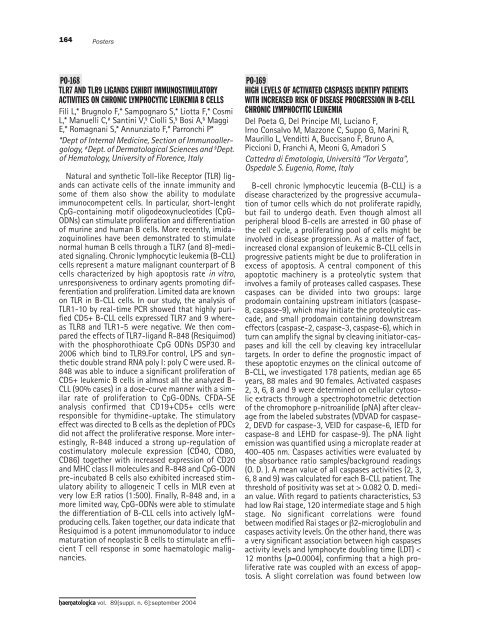Haematologica 2004;89: supplement no. 6 - Supplements ...
Haematologica 2004;89: supplement no. 6 - Supplements ...
Haematologica 2004;89: supplement no. 6 - Supplements ...
Create successful ePaper yourself
Turn your PDF publications into a flip-book with our unique Google optimized e-Paper software.
164PostersPO-168TLR7 AND TLR9 LIGANDS EXHIBIT IMMUNOSTIMULATORYACTIVITIES ON CHRONIC LYMPHOCYTIC LEUKEMIA B CELLSFilì L,* Brug<strong>no</strong>lo F,* Sampognaro S,* Liotta F,* CosmiL,* Manuelli C, # Santini V, § Ciolli S, § Bosi A, § MaggiE,* Romagnani S,* Annunziato F,* Parronchi P**Dept of Internal Medicine, Section of Immu<strong>no</strong>allergology,# Dept. of Dermatological Sciences and § Dept.of Hematology, University of Florence, ItalyNatural and synthetic Toll-like Receptor (TLR) ligandscan activate cells of the innate immunity andsome of them also show the ability to modulateimmu<strong>no</strong>competent cells. In particular, short-lenghtCpG-containing motif oligodeoxynucleotides (CpG-ODNs) can stimulate proliferation and differentiatio<strong>no</strong>f murine and human B cells. More recently, imidazoqui<strong>no</strong>lineshave been demonstrated to stimulate<strong>no</strong>rmal human B cells through a TLR7 (and 8)-mediatedsignaling. Chronic lymphocytic leukemia (B-CLL)cells represent a mature malignant counterpart of Bcells characterized by high apoptosis rate in vitro,unresponsiveness to ordinary agents promoting differentiationand proliferation. Limited data are k<strong>no</strong>w<strong>no</strong>n TLR in B-CLL cells. In our study, the analysis ofTLR1-10 by real-time PCR showed that highly purifiedCD5+ B-CLL cells expressed TLR7 and 9 whereasTLR8 and TLR1-5 were negative. We then comparedthe effects of TLR7-ligand R-848 (Resiquimod)with the phosphorothioate CpG ODNs DSP30 and2006 which bind to TLR9.For control, LPS and syntheticdouble strand RNA poly I: poly C were used. R-848 was able to induce a significant proliferation ofCD5+ leukemic B cells in almost all the analyzed B-CLL (90% cases) in a dose-curve manner with a similarrate of proliferation to CpG-ODNs. CFDA-SEanalysis confirmed that CD19+CD5+ cells wereresponsible for thymidine-uptake. The stimulatoryeffect was directed to B cells as the depletion of PDCsdid <strong>no</strong>t affect the proliferative response. More interestingly,R-848 induced a strong up-regulation ofcostimulatory molecule expression (CD40, CD80,CD86) together with increased expression of CD20and MHC class II molecules and R-848 and CpG-ODNpre-incubated B cells also exhibited increased stimulatoryability to allogeneic T cells in MLR even atvery low E:R ratios (1:500). Finally, R-848 and, in amore limited way, CpG-ODNs were able to stimulatethe differentiation of B-CLL cells into actively IgMproducingcells. Taken together, our data indicate thatResiquimod is a potent immu<strong>no</strong>modulator to inducematuration of neoplastic B cells to stimulate an efficientT cell response in some haematologic malignancies.PO-169HIGH LEVELS OF ACTIVATED CASPASES IDENTIFY PATIENTSWITH INCREASED RISK OF DISEASE PROGRESSION IN B-CELLCHRONIC LYMPHOCYTIC LEUKEMIADel Poeta G, Del Principe MI, Lucia<strong>no</strong> F,Ir<strong>no</strong> Consalvo M, Mazzone C, Suppo G, Marini R,Maurillo L, Venditti A, Buccisa<strong>no</strong> F, Bru<strong>no</strong> A,Piccioni D, Franchi A, Meoni G, Amadori SCattedra di Ematologia, Università “Tor Vergata”,Ospedale S. Eugenio, Rome, ItalyB-cell chronic lymphocytic leucemia (B-CLL) is adisease characterized by the progressive accumulatio<strong>no</strong>f tumor cells which do <strong>no</strong>t proliferate rapidly,but fail to undergo death. Even though almost allperipheral blood B-cells are arrested in G0 phase ofthe cell cycle, a proliferating pool of cells might beinvolved in disease progression. As a matter of fact,increased clonal expansion of leukemic B-CLL cells inprogressive patients might be due to proliferation inexcess of apoptosis. A central component of thisapoptotic machinery is a proteolytic system thatinvolves a family of proteases called caspases. Thesecaspases can be divided into two groups: largeprodomain containing upstream initiators (caspase-8, caspase-9), which may initiate the proteolytic cascade,and small prodomain containing downstreameffectors (caspase-2, caspase-3, caspase-6), which inturn can amplify the signal by cleaving initiator-caspasesand kill the cell by cleaving key intracellulartargets. In order to define the prog<strong>no</strong>stic impact ofthese apoptotic enzymes on the clinical outcome ofB-CLL, we investigated 178 patients, median age 65years, 88 males and 90 females. Activated caspases2, 3, 6, 8 and 9 were determined on cellular cytosolicextracts through a spectrophotometric detectio<strong>no</strong>f the chromophore p-nitroanilide (pNA) after cleavagefrom the labeled substrates (VDVAD for caspase-2, DEVD for caspase-3, VEID for caspase-6, IETD forcaspase-8 and LEHD for caspase-9). The pNA lightemission was quantified using a microplate reader at400-405 nm. Caspases activities were evaluated bythe absorbance ratio samples/background readings(O. D. ). A mean value of all caspases activities (2, 3,6, 8 and 9) was calculated for each B-CLL patient. Thethreshold of positivity was set at > 0.082 O. D. medianvalue. With regard to patients characteristics, 53had low Rai stage, 120 intermediate stage and 5 highstage. No significant correlations were foundbetween modified Rai stages or β2-microglobulin andcaspases activity levels. On the other hand, there wasa very significant association between high caspasesactivity levels and lymphocyte doubling time (LDT)
















